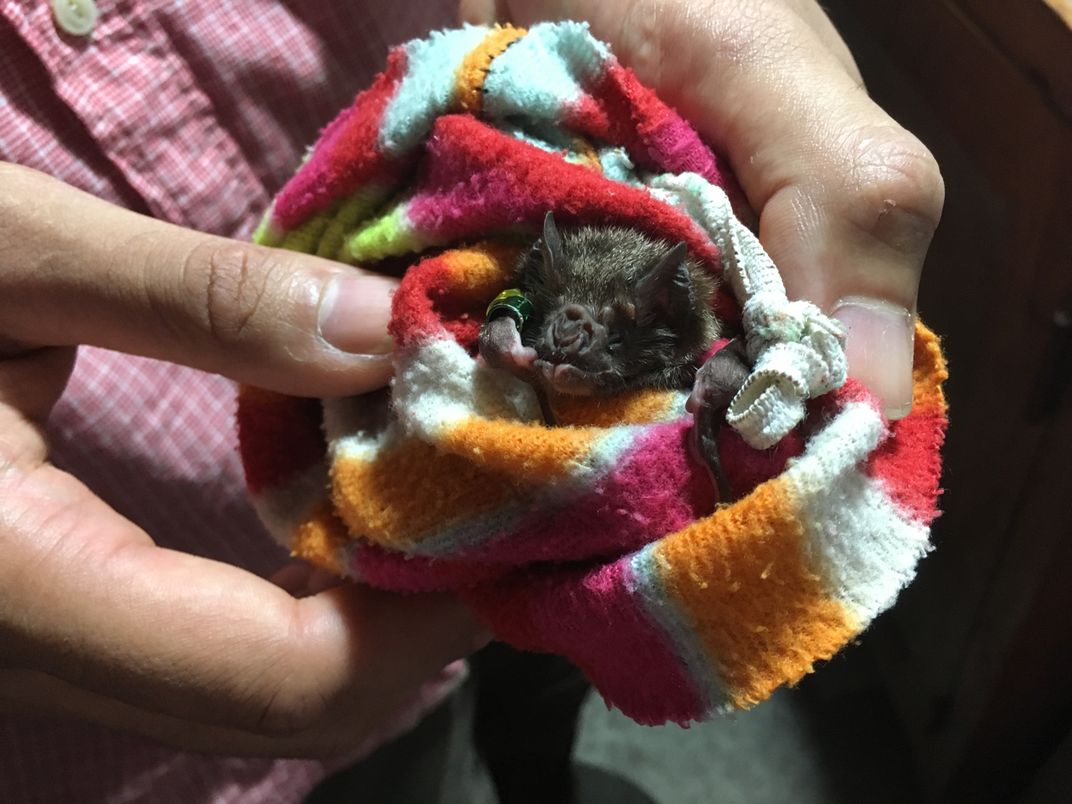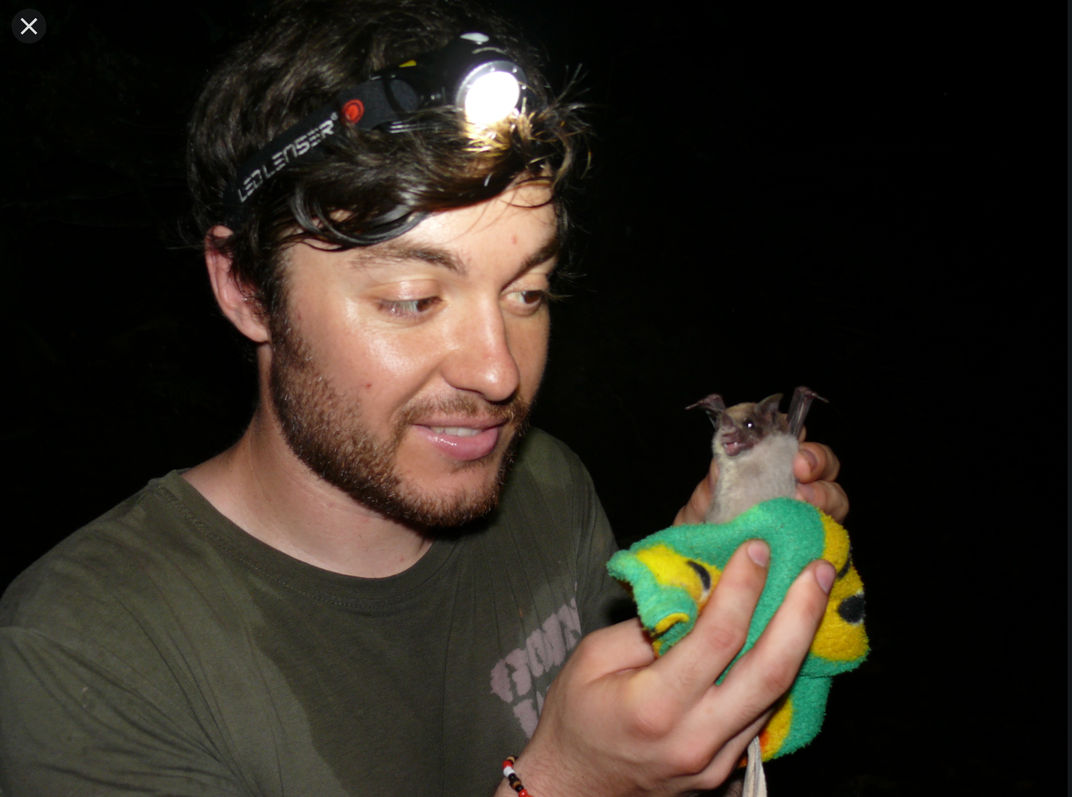When Illness Strikes, Vampire Bat Moms Will Still Socialize With Their Kids
Studying how bats behave when they’re feeling ill could help researchers better understand how pathogens move through close-knit populations
/https://tf-cmsv2-smithsonianmag-media.s3.amazonaws.com/filer/0f/55/0f5594d0-1eb9-4acd-8481-58e4579ff127/226180.jpg)
Infections don’t just wreak havoc on the body: They put a serious damper on social lives, too. But for every casual coffee date or game night lost to the misery of malady, there’s usually a close friend or family member who’s willing to stick by their loved ones through even the worst illnesses—germs and all.
This heartwarming trope, long known to be true in humans, may dictate infectious interactions between vampire bats, too, new research shows. When these bitty blood-sippers are feeling under the weather, they still cozy up to the closest of kin to exchange food and groom each other—even after they’ve stopped extending some of those same courtesies to casual acquaintances.
The findings, published recently in the Journal of Animal Ecology, do more than offer a stirring glimpse into the enduring bonds between vampire bats, who stick together in sickness and in health. By examining how illness alters social behaviors, they could also reveal how infectious diseases ripple through close-knit populations—and which individuals might play the biggest roles in passing pathogens along.
Faced with the threat of disease, “some relationships will be stronger than others,” says study author Gerald Carter, a behavioral ecologist at Ohio State University and a research associate at the Smithsonian Tropical Research Institute. As is often the case in humans, he adds, some vampire bat infections may get their start in family groups.
“It’s really important to take away that the impacts [of social structure] are nonrandom,” says Hannah Kim Frank, a disease ecologist at Stanford University who wasn’t involved in the study. During an outbreak, she says, the “who” of an infection can matter as much as the “what.”

Years ago, when researchers first attempted to forecast how infections spread through communities, their models were simple. Once an individual was stricken with a disease-causing microbe, all its peers—regardless of relationship—were believed to be equally likely to contract it.
Reality, of course, gets much more complex. Those in closer physical proximity are more likely to exchange germs; so are those who spend more time together. The idea boils down to math: More space, or more time, means more disease transmission.
The bats in the study suggest an even further layer of nuance, says study author Sebastian Stockmaier, a biologist at the University of Texas at Austin. To better monitor and predict a pathogen’s spread, Carter says, researchers should take into account the quality of relationships, rather than just quantifying them.
Though our diets drastically differ, vampire bats bear some striking behavioral similarities to humans, and are even capable of establishing friendship-like bonds. Raised in female-dominated colonies, the teacup-sized mammals will roost in groups that can number in the hundreds. Conscientious about hygiene, they’ll also clean and preen each other’s fur. And when a nighttime hunt goes awry, vampire bats will gather around a famished friend or family member to feed them gulps of regurgitated blood, passed directly from mouth to mouth.
These intimate interactions are based on reciprocity, with moms and their young staying especially close, and don’t seem heavily affected by feelings of sickness, the researchers found.
After bringing 24 wild-caught female vampire bats to the Smithsonian Tropical Research Institute, the team simulated a series of high-stakes infections on the animals and their 12 captive-born offspring. They first fasted the bats one by one, then injected them with bits of bacterial cell membranes—which, in an almost vaccine-like fashion, triggered an immune response and several of the symptoms of illness without causing actual disease.
When hungry, unwell animals rejoined their captive colony, they spent less time grooming, and being groomed by, unrelated bats. But they were just as likely to clean the fur of parents or offspring, and were gifted with just as many mouthfuls of blood by kin and non-kin alike.

These results underscore the strength of the bonds that exist between moms and their young, Stockmaier says. While a sick female bat might be less inclined to fuss over an acquaintance in need, she’s more likely to tough it out when her children are at stake—a sentiment many human moms can sympathize with.
But intimacy can also breed strife when an infection strikes—and the resilience of these relationships may inform how a disease spreads in real time. Among people, outbreaks often start when pathogens hop from family member to family member; the same might be true in bats and other social species who keep close to sick relatives.
These behaviors aren’t universal, though: Some animals, including mice and ants, appear to self-quarantine when they’re sick, isolating themselves from the rest of the community to stem the spread of disease.
Through that lens, vampire bats’ relentless congregating might seem maladaptive. But perhaps the benefits of maintaining their relationships simply outweigh the potential costs of acquiring an infection, says Daniel Becker, an infectious disease ecologist at Indiana University who wasn’t involved in the study. In this species, meal sharing is vital: Vampire bats can die after going just two or three days without food. “From an evolutionary standpoint, it makes sense,” Becker says. Even when one partner isn’t in tip-top shape, “if the choice is between ‘you’re sick’ versus ‘you starve to death,’ you’re going to choose to share blood.”
Because the animals in the study weren’t grappling with an actual pathogen, the results shouldn’t be overgeneralized to other social species—or even to other infections that plague vampire bats themselves, including viruses like rabies. Unfortunately, when it comes to studying disease dynamics, Frank says, “the general rule is, ‘It depends.’”
Still, investing in studies like these could help researchers better simulate how outbreaks start and spread, says Patricia Lopes, who studies how infections affect animal behavior at Chapman University, but wasn’t involved in the study. “The more detailed information we can input in disease transmission models, the more precise they’re going to be.”
/https://tf-cmsv2-smithsonianmag-media.s3.amazonaws.com/accounts/headshot/10172852_10152012979290896_320129237_n.jpg)
/https://tf-cmsv2-smithsonianmag-media.s3.amazonaws.com/accounts/headshot/10172852_10152012979290896_320129237_n.jpg)